Scuba Diving in Ha Long Bay: Ultimate Guide to Vietnam's Underwater Paradise
Ha Long Bay, a UNESCO World Heritage Site in Vietnam, is renowned for its breathtaking landscape of thousands of limestone islands and emerald waters. While the bay's spectacular above-water scenery attracts millions of visitors each year, there lies an equally captivating world beneath its surface. Scuba diving in Ha Long Bay offers a unique opportunity to explore underwater geological formations, colorful coral reefs, and diverse marine life that few travelers get to experience.
An Introduction to Ha Long Bay's Underwater World
The underwater environment of Ha Long Bay presents a fascinating contrast to its famous above-water scenery. Below the emerald surface, divers can discover a mesmerizing world of underwater caves, intricate geological structures, and the bases of towering limestone karsts that extend from the seabed. This unique underwater landscape, combined with the bay's rich marine biodiversity, creates a diving experience unlike any other in Southeast Asia. Thanks to improved accessibility through Van Don Airport, reaching this hidden world has never been easier for adventurous travelers.
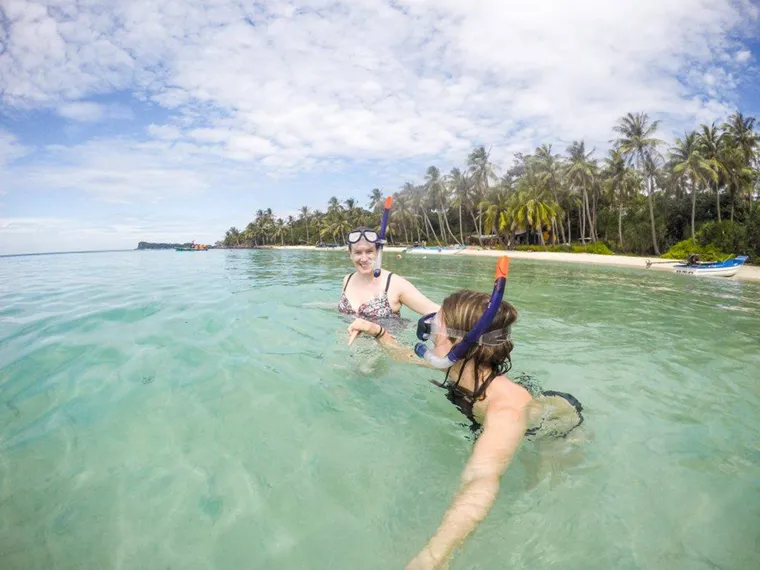
The bay’s underwater environment features intricate geological structures, submerged karsts, and rich biodiversity - Photo Source: Fanpage Halong Bay
Water clarity in Ha Long Bay is generally good, especially during the ideal diving season, providing excellent underwater visibility that enhances the enjoyment of exploring the marine environment. The combination of unique geological features and abundant marine life makes Ha Long Bay a special diving destination, capable of attracting both beginners and experienced divers seeking an experience different from typical tropical coral reefs.
Top Diving Sites in Ha Long Bay
Ha Long Bay and its surrounding areas offer several exceptional diving locations, each providing unique underwater experiences:
Lan Ha Bay
Often cited as one of the premier diving spots, Lan Ha Bay boasts crystal-clear waters, vibrant coral reefs, and an abundance of tropical fish and sea turtles. A specific site within Lan Ha Bay, Fan Reef, is famous for its diverse coral formations.
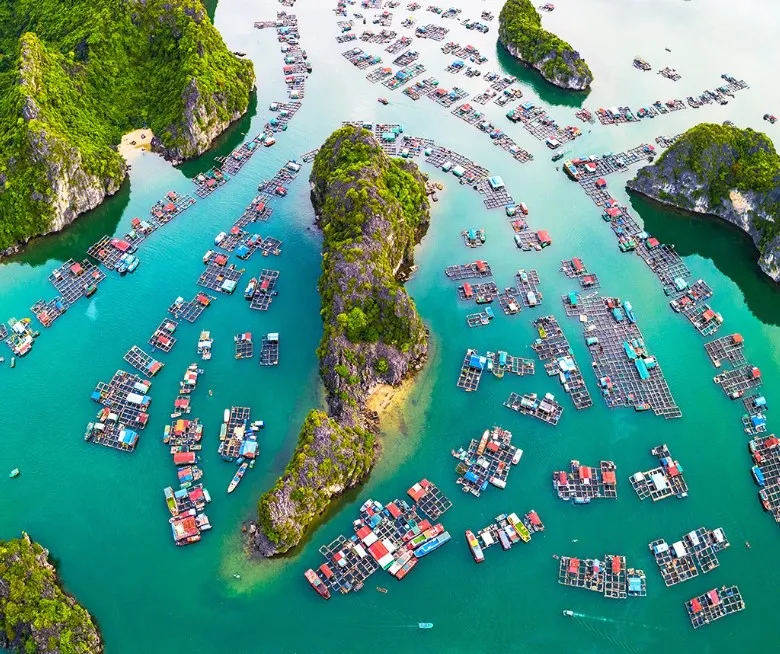
Known for its clear waters, colorful coral reefs, and diverse marine life, with Fan Reef being a highlight - Photo Source: Facebook Welcome to Vietnam
Cong Do Island
This island is renowned for its mesmerizing underwater caves and tunnels, as well as a diversity of marine life including stingrays and reef sharks. Notable diving sites here include the Coral Garden, Blue Tunnel, and Devil's Face Cave, as well as the Brain Coral Garden.
Vung Ha Island
Located in the central area of Ha Long Bay, this island features rock formations, hidden caves, and vibrant coral formations with numerous marine species, including seahorses and sea cucumbers. The Sponge Garden is another highlight here.
Cat Ba Island
As the largest island in the Ha Long Bay archipelago, Cat Ba boasts a diverse coral reef system and is home to various marine creatures such as red frogfish, abalone, and pearl oysters.

The largest island in Ha Long Bay, home to diverse coral reefs and marine life including red frogfish and pearl oysters - Photo Source: Facebook Du Lịch Cát Bà
Other Notable Sites
Other mentioned locations include Van Don Island (Cai Bau Island) in Bai Tu Long Bay and Co To Island, particularly Hong Van Beach, known for its clear waters and coral reefs.
The diversity of these diving sites (coral reefs, caves, varied marine life) indicates that Ha Long Bay can cater to divers with different interests and experience levels, allowing visitors to choose a location based on their preferences.
Best Time for Diving in Ha Long Bay
Most sources agree that the best time for diving and snorkeling in Ha Long Bay is from May to November, encompassing the summer and autumn months.
During this period, weather conditions are typically favorable with warm water temperatures ranging from 25 to 29 degrees Celsius, calm seas, and good underwater visibility.
June through August are particularly popular due to the warmest water and best visibility. However, these months also represent the peak tourist season, meaning diving sites may be more crowded and prices higher.

The ideal diving season runs from May to November, with the best visibility and warm waters from June to August, though typhoons can occur in late summer - Photo Source: Facebook Halong Bay Vietnam - Du Lịch Vịnh Hạ Long
Autumn (August to October) is also considered a good time, with pleasant weather, although natural light may be slightly weaker, potentially affecting visibility marginally. This is also noted as a peak season.
It's important to note that typhoons can occur, especially in late summer (August to early September). Checking weather forecasts is advisable. Winter (December to April) is generally not recommended due to colder temperatures.
The extended period from May to November provides a broad window for diving activities, offering flexibility for travelers. However, considering the trade-offs between optimal conditions, crowds, and potential typhoons is crucial for planning. The shoulder months at the beginning and end of the season (May and September/October) may offer a good balance between favorable diving conditions and fewer crowds compared to the peak summer months.
Requirements and Certifications for Diving in Ha Long Bay
Physical Requirements
Generally, participation in diving activities requires a basic level of physical fitness and freedom from certain medical conditions, particularly heart and lung issues. Consulting with a doctor is recommended if there are any health concerns.
Certification Requirements
For those wishing to dive independently or at more advanced diving sites, having a recognized diving certification, such as a PADI Open Water Diver certificate, is typically mandatory. This certification usually includes a 3-4 day course covering theoretical knowledge, pool sessions, and ocean dives.
Some diving operators may offer introductory dives or "discover scuba" experiences for beginners without certification. These dives are typically conducted under the direct supervision of a certified instructor and in shallower waters, with depth limitations.
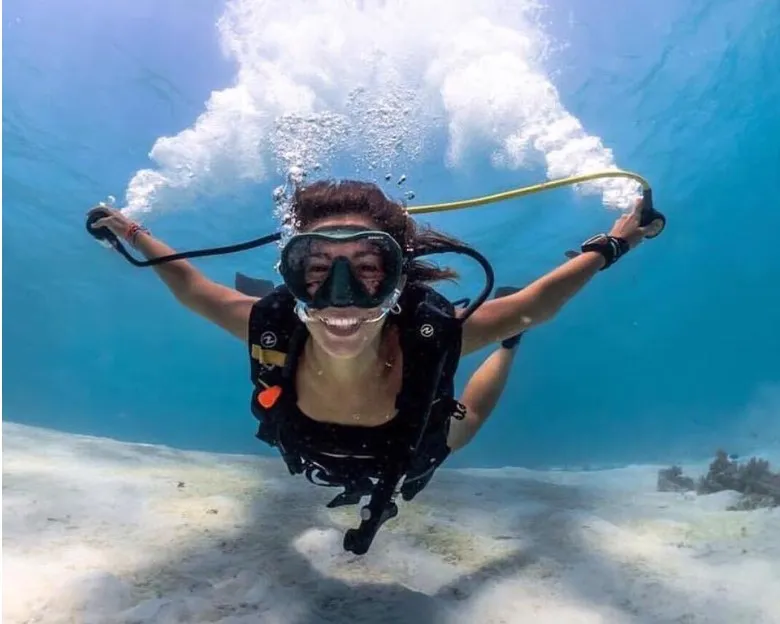
Divers need basic physical fitness, with certifications like PADI required for independent dives, though introductory dives are available for beginners - Photo Source: Facebook Scuba Diving international
Popular diving certification organizations include PADI (Professional Association of Diving Instructors) and SSI (Scuba Schools International). While introductory dives provide a trial experience of scuba diving, obtaining an Open Water Diver certification offers greater flexibility and access to more diving sites in Ha Long Bay.
Users planning multiple dives or wanting more independence should consider getting certified. The mention of a minimum age of 10 years for scuba diving is an important factor for families planning to travel. However, it should be noted that this may vary between operators.
Cost of Diving Tours and Packages
Information about specific costs for diving tours in Ha Long Bay from the provided excerpts is limited and varies.
One source mentions an estimated cost of about 15,000 VND (approximately $60 USD) for a complete diving expedition, including equipment rental and guide. However, this figure should be considered an estimate and may vary depending on the operator, location, and dive time.
Prices for Ha Long Bay tours in general, some of which may include scuba diving or snorkeling, range from about $22 USD to over $300 USD per person. It's important to carefully review the included services of these tours to determine if diving is part of the package and for how long. If you're flying in, factor in the cost and convenience of getting from Van Don airport to Ha Long Bay, which is a common route for travelers seeking direct access to the bay’s adventure activities.
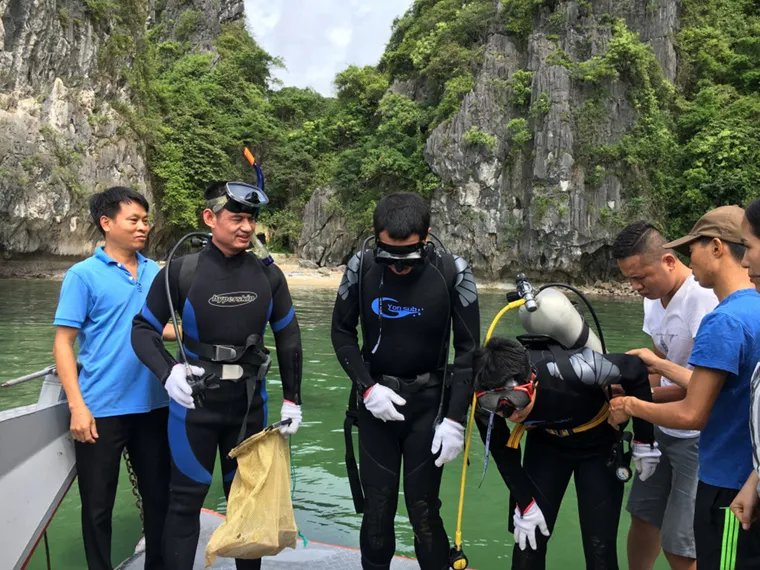
Diving tour prices vary widely, typically ranging from $60 to several hundred dollars depending on the package, duration, and included services - Photo Source: baoquangninh.vn/
A 3-day tour departing from Hanoi and including both kayaking and diving at two different locations suggests that multi-day packages incorporating diving are available. However, the specific price for this tour is not provided in the excerpt.
The significant price range for Ha Long Bay tours in general emphasizes the importance of users specifically inquiring about diving-focused tours and comparing included services and dive times offered by different operators. The mention of a specific price for a diving expedition provides a preliminary benchmark, but users should anticipate potential variations based on the quality of the operator, equipment, and diving location.
Safety Guidelines and Regulations for Diving in Ha Long Bay
Safety should be the top priority when diving. Whether you're following a Halong itinerary for solo travelers or joining a group, it’s highly recommended to dive only with certified, reputable centers or guides to ensure proper supervision and well-maintained equipment. It is highly recommended to dive with certified and reputable centers or guides to ensure proper guidance and equipment.
Divers must always follow the safety instructions and rules provided by diving professionals, including adherence to depth limits and decompression stops.
Diving with a buddy is essential for safety. Never dive alone.
Before diving, it's important to ensure that all diving equipment, such as masks, fins, snorkels, tanks, and diving suits, are in good condition and meet safety standards.
Divers should be mindful of the marine environment and practice proper buoyancy control to avoid damaging coral reefs and disturbing marine life.
An important piece of information from the excerpts is that diving and snorkeling activities have been temporarily suspended in Ha Long Bay to protect biodiversity and the ecosystem. The current status of this suspension needs to be verified before planning a trip.
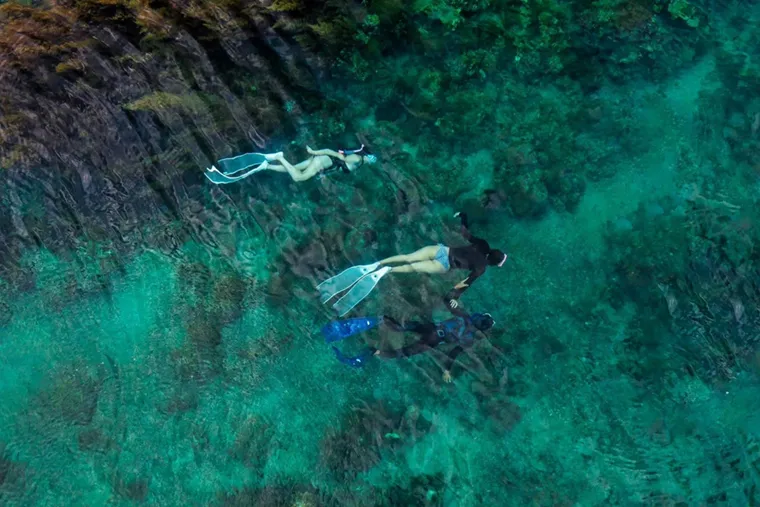
Following safety protocols, using reputable operators, diving with a buddy, and checking the latest local regulations are essential for a secure experience - Photo Source: baoquangninh.vn
While some excerpts mention general safety tips for water activities in Vietnam, official specific regulations for recreational diving in Ha Long Bay are not highlighted in the provided material. Divers should rely on the safety procedures of reputable operators and international diving standards.
The potential temporary suspension of diving activities is a crucial factor that users must investigate before making any plans. This highlights the importance of checking the most up-to-date information from official tourism sources.
The emphasis on choosing certified operators and following safety guidelines indicates the importance of prioritizing safety over cost or convenience when selecting a diving service provider.
Preparing for Your Ha Long Bay Diving Experience
Essential Gear for Diving in Ha Long Bay
While most diving operators provide all necessary equipment, it's helpful to understand what you'll be using:
-
Diving mask and snorkel: For clear visibility underwater and breathing on the surface
-
Wetsuit: Even in warm waters, a thin wetsuit (3mm) is recommended for protection
-
Fins: For efficient movement underwater
-
Buoyancy Control Device (BCD): To control your buoyancy underwater
-
Regulator: For breathing underwater from your tank
-
Dive computer: To monitor depth, time, and no-decompression limits
-
Weight belt: To help maintain neutral buoyancy
Consider bringing your own mask if you have one that fits well, as this is the most personal piece of equipment.
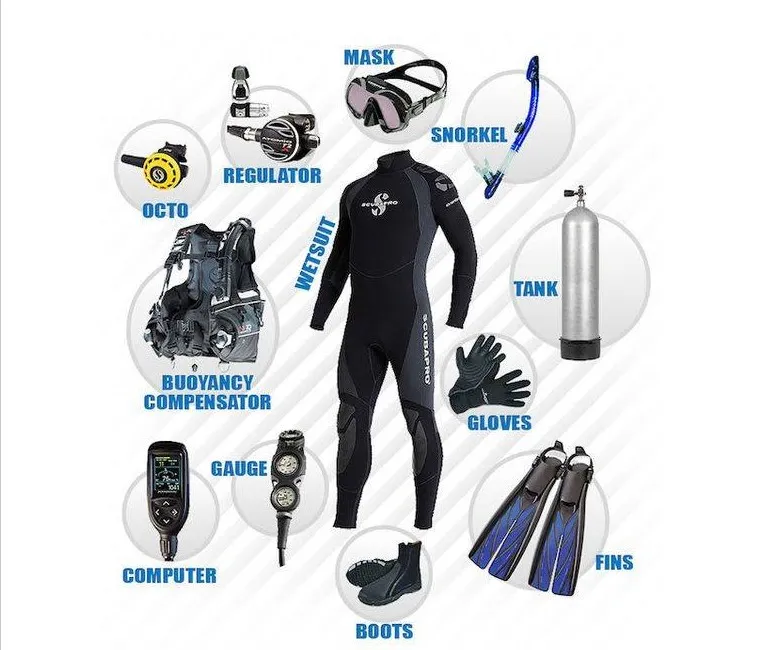
Proper preparation includes having essential gear, bringing personal items like sunscreen and a camera, and ensuring good physical and mental readiness - Photo Source: Scuba Diving international
What to Bring on a Diving Trip
Beyond diving equipment, here are some essentials for your diving excursion:
-
Reef-safe sunscreen: Protect your skin without harming marine life
-
Rashguard or UV shirt: Additional protection from sun and minor scratches
-
Towel and dry clothes: For after your dive
-
Waterproof camera: To capture your underwater experience
-
Water bottle: Stay hydrated before and after diving
-
Personal medications: Including any seasickness remedies if needed
-
Dive log book: If you're certified and want to record your dives
Physical Preparation
If you're new to diving or haven't dived recently, consider these preparation tips:
-
Basic swimming practice: Refresh your swimming abilities before your trip
-
Breathing exercises: Practice slow, deep breathing to optimize your air consumption underwater
-
Basic fitness: While diving isn't extremely strenuous, some cardiovascular fitness helps
-
Rest well: Ensure you're well-rested before diving day
-
Stay hydrated: Drink plenty of water before and after diving
-
Avoid alcohol: Don't drink alcohol the night before diving
Experiencing Marine Life in Ha Long Bay
The underwater world of Ha Long Bay offers diverse marine encounters that make each dive memorable. Here's what you might expect to see:
Common Marine Species
-
Colorful reef fish: Look for schools of butterflyfish, angelfish, and the iconic clownfish (finding Nemo!)
-
Larger inhabitants: Occasional sightings of reef sharks, rays, and moray eels
-
Invertebrates: Sea anemones, nudibranchs, sea stars, and various crustaceans
-
Unique specimens: Red frogfish, seahorses, and various species of sea cucumbers
Coral Formations
Ha Long Bay features different coral types than many tropical destinations. You'll encounter:
-
Brain corals: Massive, spherical corals with winding patterns resembling a brain
-
Table corals: Flat, wide formations providing shelter for many small fish
-
Soft corals: Swaying, colorful formations that add movement to the underwater landscape
-
Sponges: While not technically corals, these colorful filter-feeders add diversity to the reef ecosystem
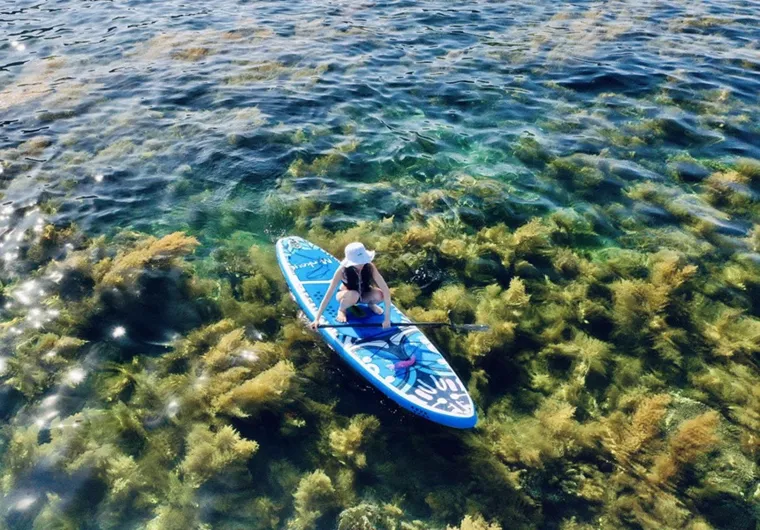
Divers can encounter colorful fish, reef sharks, seahorses, and various coral formations, making each dive an exciting underwater adventure - Photo Source: baoquangninh
Underwater Photography Tips
For those looking to capture their underwater experiences:
-
Master buoyancy first: Good buoyancy control prevents damaging marine life and ensures clear photos
-
Get close: Water reduces color and clarity, so get as close as safely possible to your subject
-
Use natural light: When possible, utilize sunlight rather than artificial flash
-
Shoot upward: Compose shots toward the surface for better lighting and interesting perspectives
-
Be patient: Wait for the perfect moment when fish are positioned well
-
Practice on stationary subjects: Start with non-moving subjects like corals before attempting to photograph fast-moving fish
Practical Tips for First-Time Divers in Ha Long Bay
If you're new to diving or this is your first time diving in Ha Long Bay, these practical tips will help ensure a smooth experience:
Choosing the Right Diving Operator
-
Research thoroughly: Read reviews from multiple sources, not just operator websites
-
Check certifications: Ensure the operator and instructors hold recognized certifications
-
Inquire about group sizes: Smaller groups generally mean more personalized attention
-
Verify equipment quality: Ask about the age and maintenance of diving equipment
-
Discuss experience levels: Make sure the operator offers appropriate options for your skill level
Managing Expectations
-
Visibility varies: Water clarity in Ha Long Bay can change with seasons and weather
-
Marine life sightings: Understand that wildlife encounters can't be guaranteed
-
Weather conditions: Be prepared for possible changes in diving plans due to weather
-
Comfort level: Communicate openly with your instructor about your comfort and concerns
Conclusion and Final Recommendations
Scuba diving in Ha Long Bay offers a unique opportunity to explore an underwater world as magnificent as the bay's famous above-water scenery. From vibrant coral gardens and mysterious caves to diverse marine life, diving here provides experiences that complement the traditional junk boat tours and surface-level sightseeing.
Whether you're an experienced diver or a curious beginner, Ha Long Bay's underwater environment promises memorable encounters and perspectives few travelers get to experience. By approaching your diving adventure with proper preparation, respect for the environment, and an open mind, you'll discover another dimension of this UNESCO World Heritage Site that will enhance your appreciation of Vietnam's natural wonders.
With a well-planned itinerary, budget-friendly options, and an open mind to meeting new people, your solo journey will be both fulfilling and exciting. Let Joytime be your trusted companion, providing essential travel gear to ensure comfort, safety, and convenience throughout your trip. An incredible solo adventure awaits—pack your bags and explore Ha Long Bay's underwater treasures with confidence!
|
Joytime Travel Agency - Travel JOY, TIMEless Vietnam Follow us for travel tips, local insights, and exclusive offers:
|

Danish Nguyen
Danish Nguyen is a renowned travel blogger in Vietnam with over 5 years of experience sharing unique travel experiences. With a passion for exploring new places, Danish captures incredible moments and provides readers with valuable tips to discover the beauty of his homeland.


















